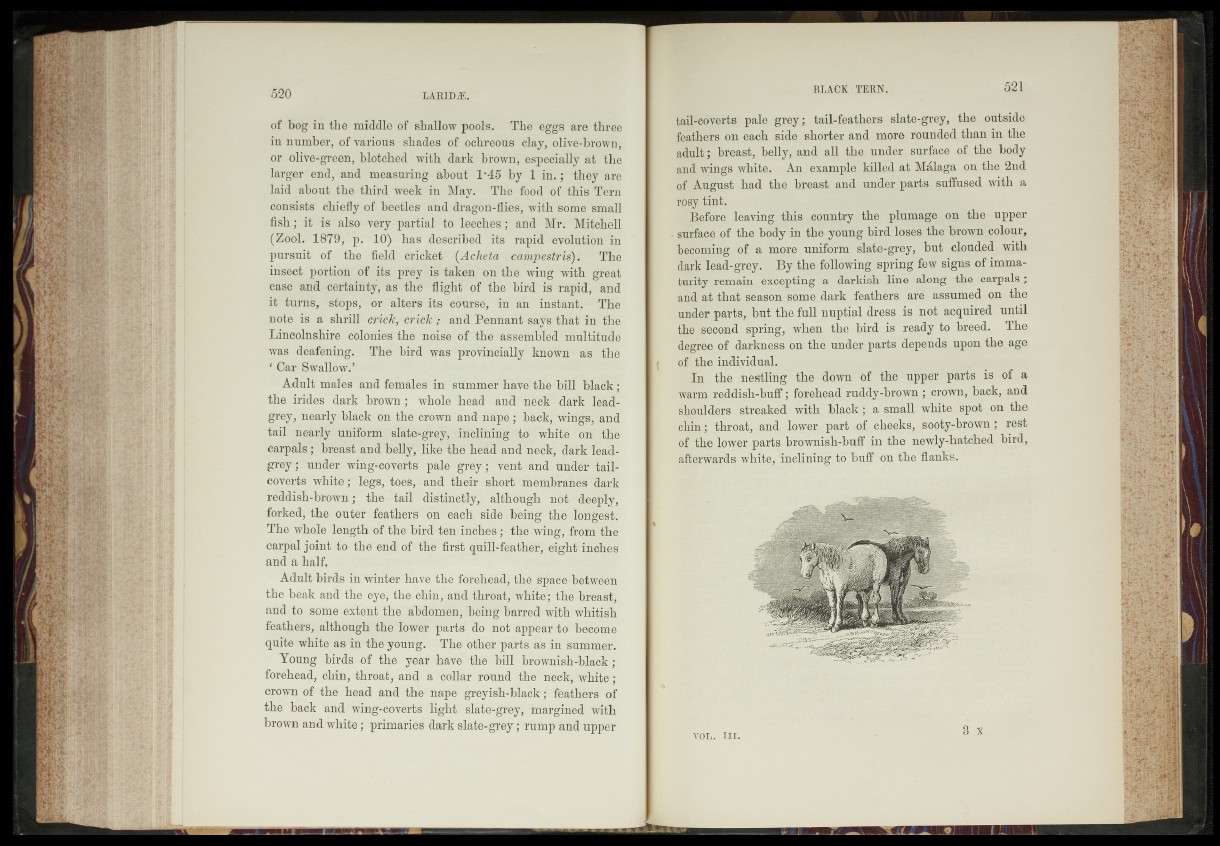
520 LARIDÆ.
of bog in the middle of shallow pools. The eggs are three
in number, of various shades of ochreous clay; olive-brown,
or olive-green, blotched with dark brown, especially at the
larger end, and measuring—about 1-45 by 1 -îh.-; -they are
laid about the third week in May.-' ^TBefoed h f thib^'lfri
consists chiefly of beetles and dragon-flies, with some small
fish ; it is also very partial tö lëéchef ; and Mitchell
(Eooh 1879, p^LO) has deéeriBëd w rapid bvblütïen'in
pursuit of the field cricket ôâmpèàtÆ) The
insect portion of its prey 4s-taken on the wiirg with gréât
ease and certainty, as the "flight of the bird' is rapid, and
I t turns, Stops, or alters its coiif-se, in an instShtl« "Tfee
note is a shrill crick, crick ; and Pennant says that in the
Lincolnshire colonies the noise of fhë^àMsëmbled multitude
was deafening. The bird was prbvin'cially known-' ras f ther
‘ Car Swallow.’
Adult males and females in summer*have"ttle Till black ;
the irides- dark brown ; while head and nèck - dai?k lead-
grey, nearly black ©n the crown and nape ; back, wingsf*and
tail nearly uniform slate-grey; -^Mcliffing io- whilé TilfThe
carpals ; breast and belly, likelhè heM and neckV ‘darkTëad-
grey; 'under tving-coverts pale'grey; vént and under tafl-
coverts white;Tegs, toes, àndHtkÉr éhorî -memWraÈél'dark
reddish-brown-; the Tail •-•distinctly, altMtfgh ^^-déëpfy,
forked, the outer feathers' nn each" si dé -bein^TKBflo^yt.
The whole lfength of The bird téndnche'S;- ' ’tÉjé^in g; frnfn^the'
carpal joint to the end o f-^^first quill-feather,^i^0t-inShes
and a half.
Adult birds in winter nav©T%e foreheadpthe Sp'ace botvoen
the beak and the éyëy- the chin, and throat, wlifceTthe breast,
and to some exLentTh'ëyabdômen,Sëingba-rred wiflf wMtish'
feathers, although''the'dS#ér parts do' not=â||liaiTo- Técóine
quite white as inThlfyouhg. • Thé htler^paft^s in summer.
Young birds of the year haveThe bill btównisb-black ;
forehead, chin, throat,4ând a c'ollar %ound the- néfellf?\vhile ;
crown of the; head and the 'to f# greyfetobïtoföfTéathëW' of
the back and wmg-ceve#sT%h# slâtë'-ffèy; margined wajlf1
brown and white ; primaries -I&rk‘ s‘lafe^cy*f-ru>mf and upper
BLACK TERN. 521
tail-coverts pale grey; tail-feathers slate-grey, the outside
feathers on each side shorter and more rounded than in the
adult;- breast, belly, and all the .-under, surface the body
and-wings white. An example-.killed at Malaga on the 2nd
of ^August had the. breast, and under parts suffused with a
rpsy tint.
llPefore leaving this country the plumage on the - upper
surface of the body in the young bird loses the brown colour,
becoming of a more uniform slate-grey, but'.-plouded wjth
dark lead-gi;ey. By the following spring few signs of immaturity
remain -excepting a darkish line along the carpals;
and at that season-some_dark feathers are assumed o,n the
under parts, but jt|(e full nuptial dress is not acquired until
thtoseCond spring, when the. bird is ready to breed. The
degree of darkness qntthe under-parts depends upon the-age
of Jhe individual.,
In the-nestling' thé down óf thé upper paffe t o of a
warm reddish-buff; forehead ruddy-jbrown; crown^ back, and
Cfofulders streaked' with black; a small white- spot on the
Chin ; throat, and lower -part ,;o£5pheeks, saq-lyrbrqwn^; rest
of the lower parts brownish-buff in the newly-hatched bird,
afterwards vMjtq, inclining to Buff on -the'flanks.
VOL. HI. b m